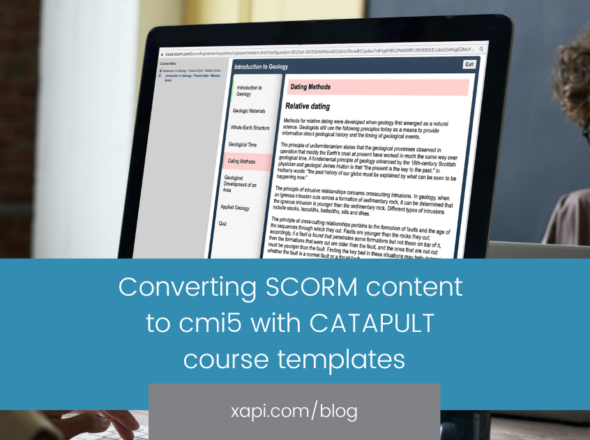Last week wraps up a year of work on Project CATAPULT, which is now officially being called cmi5 CATAPULT. To wrap up the project, Brian Miller and George Vilches led a webinar with the ADL Initiative to unveil the new cmi5 conformance tools that are now available. If you missed it, the full webinar is available here and walks through the cmi5 LMS Test Suite (LTS), Player Prototype, cmi5 Content Test Suite (CTS) and example courseware for migrating legacy SCORM content.
Attendees had a lot of great questions about cmi5 and the CATAPULT tools. Here’s a recap of what was asked and our answers.
What will future activities using cmi5 look like and how different it will be from today? What would be a striking example that cmi5 today is “the place to be”?
Great questions! cmi5 specifically solves the LMS and xAPI use case. cmi5 has all the advanced tracking capabilities and user experience improvements that xAPI provides while being able to launch the content from an LMS. This means you can add simulations, virtual reality, augmented reality, serious games and other newer technologies that aren’t necessarily browser-based courses to your learning and training program and still be able to use an LMS as long as it’s cmi5 conformant. If you’ve created a large content library, you can migrate your existing content to cmi5 using the course templates as guides and reap the xAPI benefits.
Ultimately, cmi5 and xAPI will help with accelerating the move to more modern learning and training environments with much deeper insights into learning activities, or courses, than was possible with SCORM.
Could you briefly explain xAPI Profiles and how it enhances xAPI?
Without any defined rules, xAPI Statements can be populated with data that meets the standard, but are not semantically well-organized which could lead to inaccurate analytics. The xAPI Profile Specification was introduced to combat this by defining vocabulary, contexts and rules for how xAPI data interacts within a particular domain.
Part of cmi5’s role as an xAPI Profile is to define rules for how populated xAPI statements are organized and sent to the LRS. cmi5 provides a semantic model for centralizing common values often needed in reporting, including success status, completion status, score and time, which the xAPI standard, on its own, doesn’t specify.
Essentially, xAPI Profiles provide rules that help to achieve a successful implementation and semantic interoperability of xAPI data across systems.
Assignable Units (AUs) are defined in cmi5.xml? Can these be nested?
AUs are not able to be nested as they are the launchable resource. “Blocks” are able to be nested and contain one or more AU(s) as well as zero or more blocks. The hierarchy is defined by the cmi5.xml. Once the final requirements of all AUs in a block are satisfied, then the block is considered satisfied.
Where can I find the setup steps for the CTS?
All cmi5 CATAPULT documentation, including the setup steps for the CTS, are included in the code repository and via the user guide. All cmi5 CATAPULT documentation can be found here.
Have testers integrated with CI/CD platforms like Jenkins?
The cmi5 LMS Test Suite can be integrated via CI/CD fairly easily. It provides a JUnit formatted XML artifact that should be usable via a Jenkins pipeline. The CTS isn’t really able to be automated in the same way because we can’t know what the content will expect to do. Having said that, you could, in theory, script the execution of the CTS itself with a specific library of content such that it could be brought into CI/CD.
How will LMS reporting improve with cmi5?
xAPI does not specify a defined data model to describe the “Big 4”: completion, success status, score and time. While there are some common xAPI Profiles used in popular authoring tools, such as the xAPI SCORM Profile, they aren’t universal nor are they required as part of the specification. A Tincan package (currently, most packages that can be launched from an LMS are Tincan packages since xAPI has no official launch standard of its own) does not have any requirements around those properties or any data collection at all. cmi5 conformance forces all content to be satisfiable in a way that collects these data points. This makes it much easier to ensure that LMSs will provide at least the same quality of reporting available from SCORM launches, but on a data standard that enables significantly more advanced data collection beyond the baseline.
Does the open source Player Prototype have a data call back for developer and API keys to integrate within an LMS that uses LTI or an LMS that uses plug-ins?
Integration documentation for the CATAPULT Player Prototype can be found in detail here. The Player Prototype should be treated as a component of an application that would be applied to an LMS itself in order to enable the playing of cmi5 courseware, and not as a distribution piece to directly tie into. Your platform would still be responsible for providing a reasonable interface on top of the Player Prototype to make it available in other contexts, such as LTI.
What’s next?
Help spread the word by letting LMS and authoring tool vendors know that you’re interested in cmi5. The more interest they hear, combined with the available tools, the more it will help speed up adoption rates.
And we’re already seeing users excited to start implementing the tools. Since the webinar concluded, users are now uploading and testing content in the CTS.
Want to know more about cmi5 and integrating it into your learning and training programs? Ask us!


